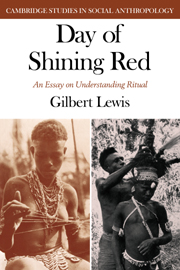Book contents
- Frontmatter
- Contents
- Analytical table of contents
- Preface
- 1 A question of interpretation
- 2 Problems of ritual in general
- 3 Views from one village
- 4 The rites of puberty seen
- 5 Rules of procedure and reflection on them
- 6 Silent forms but natural symbols?
- 7 Moon, river and other themes compared
- 8 For success in life
- 9 A choice of magic
- 10 Change and a rite falling into disuse
- 11 Inventory of themes
- References
- Index
- CAMBRIDGE STUDIES IN SOCIAL ANTHROPOLOGY
11 - Inventory of themes
Published online by Cambridge University Press: 30 October 2009
- Frontmatter
- Contents
- Analytical table of contents
- Preface
- 1 A question of interpretation
- 2 Problems of ritual in general
- 3 Views from one village
- 4 The rites of puberty seen
- 5 Rules of procedure and reflection on them
- 6 Silent forms but natural symbols?
- 7 Moon, river and other themes compared
- 8 For success in life
- 9 A choice of magic
- 10 Change and a rite falling into disuse
- 11 Inventory of themes
- References
- Index
- CAMBRIDGE STUDIES IN SOCIAL ANTHROPOLOGY
Summary
A mother feeds her child: we think we understand her action. It is a matter of experience that the sense of understanding other people's actions draws continually on familiar and subjective elements by which we attribute to others states of mind, desire, motive and purpose that we can recognise in ourselves, or feel we could. They help to make these other people's actions intelligible. We impute understanding of the purpose or feelings of the actors to them. It is often implicit and intrinsic in the verbs or words we use to describe human behaviour (e.g. ‘announce’, ‘give’, ‘feed’, ‘welcome’, ‘answer’, ‘punish’). This is generally so in the description of human behaviour, whatever the writer and his purpose – novelist, historian, anthropologist, journalist, psychologist or philosopher. Description and interpretation of human behaviour are often bound together. Wholly objective descriptions of human behaviour (and ‘pure’ descriptions of social actions a fortiori) are very hard to provide. We do not register human behaviour in a simple objective fashion but we continually seek to recognise and translate it as we perceive it into terms of understanding if we can. We do this without thinking in everyday life; many words we use to think or speak about human behaviour imply such understanding willy-nilly. But it is also a matter of everyday experience that we sometimes find other people's actions hard to understand. The effort of attempting to and failing makes by contrast the interpretative element, which is usually present but implicit, more explicit.
- Type
- Chapter
- Information
- Day of Shining Red , pp. 216 - 224Publisher: Cambridge University PressPrint publication year: 1980

